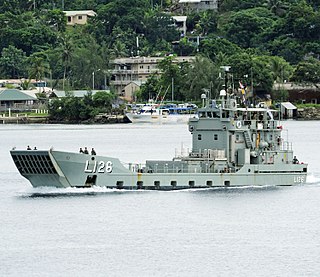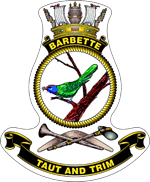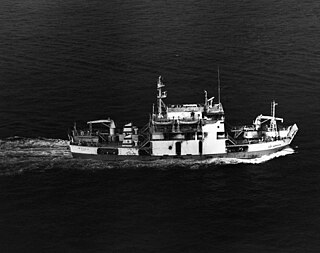HMAS Acute was an Attack-class patrol boat operated by the Royal Australian Navy (RAN).

HMAS Attack was the lead ship of the Attack-class patrol boats used by the Royal Australian Navy (RAN). Launched in April 1967 and commissioned in November that year, the ship was largely commercial in design and was used to protect fisheries in Australia's northern waters, and to support the survey ship Moresby. The vessel remained in RAN service until 1985 when it was transferred to the Indonesian Navy and renamed Sikuda.

HMAS Balikpapan was the lead ship of the Balikpapan class of heavy landing craft (LCH). Ordered in 1969, Balikpapan entered service with the Australian Army Water Transport Squadron in late 1971. After this, the decision to place all seagoing Army vessels under the control of the Royal Australian Navy (RAN) saw Balikpapan transferred and commissioned in 1974; the last of the eight-vessel class to enter RAN service. Balikpapan was placed in reserve in 1985, but was reactivated three years later. During late 1999 and early 2000, the vessel was part of the INTERFET peacekeeping taskforce, and made additional deployments to East Timor in 2001 and 2006. On 12 December 2012, Balikpapan was retired from RAN service.

HMAS Barbette was an Attack-class patrol boat of the Royal Australian Navy (RAN).

HMAS Betano was a Balikpapan-class heavy landing craft operated by the Royal Australian Navy (RAN).

The Balikpapan class is a ship class of eight heavy landing craft. All eight were originally laid down by Walkers Limited for the Australian Army in the early 1970s. A reorganisation of watercraft responsibilities in the Australian military meant the landing craft were to be operated by the Royal Australian Navy (RAN), with seven commissioned directly into RAN service during 1973 and 1974, and lead ship Balikpapan transferred from the army to the navy. During the leadup to the independence of Papua New Guinea in 1975, two of the vessels were transferred to the new Papua New Guinea Defence Force (PNGDF).

The Huon-class minehunter coastal (MHC) ships are a group of minehunters built for the Royal Australian Navy (RAN). Following problems with the Bay-class minehunters, a request for tender was issued in 1993 for a class of six coastal minehunters under the project designation SEA 1555. The tender was awarded in 1994 to the partnership of Australian Defence Industries (ADI) and Intermarine SpA, which was offering a variant of the Italian Gaeta-class minehunter.

HMAS Huon, named for the Huon River, is the lead ship of the Huon class of minehunters operated by the Royal Australian Navy (RAN). The first of six ships built by a joint partnership of Australian Defence Industries (ADI) and Intermarine SpA, Huon's hull was fabricated at Intermarine's Italian shipyard, then freighted to ADI facilities at Newcastle for completion. She entered service in 1999.

HMAS Sirius was a commercial tanker purchased by the Royal Australian Navy and converted into a fleet replenishment vessel to replace HMAS Westralia. She was named in honour of HMS Sirius of the First Fleet. Launched in South Korea on 2004, and converted in Western Australia, Sirius was commissioned in 2006; three years before a purpose-built vessel would have been built, and at half the cost. The tanker was decommissioned in 2021.

MSA Brolga (1102) was a minesweeper operated by the Royal Australian Navy (RAN) between 1988 and 2003. Launched in 1975 by Australian Shipbuilding Industries, the ship was designed for the Department of Transport as the lighthouse tender Lumen. Originally operating as a supply vessel for lighthouses around northern Queensland and the Torres Strait, the transition in lighthouse lights from acetylene gas to solar power meant there was less demand for the vessel, and by 1988, the Department of Transport was looking to sell the ship.

HMAS Wewak was the fifth ship of the Balikpapan class of heavy landing craft operated by the Royal Australian Navy (RAN).

The Kuha-class minesweepers is a series of six inshore minesweepers of the Finnish Navy. The ships were constructed in 1974–1975. All the vessels of the class were modified and modernized in the late 1990s, including a lengthening of the hull. Two of the class were withdrawn from service in 2012. The rest of the class will be retired with the entry into service of the Katanpää-class mine countermeasure vessels.

Godetia (A960) was a command and logistical support ship of the Belgian Naval Component, launched on 7 December 1965 at the Boelwerf in Temse and entered service on 2 June 1966. The patronage of Godetia was accepted by the city of Ostend. She was the first of two support ships acquired to replace World War II-era ships. Used primarily to provide logistic support to Belgium's fleet of minesweepers, Godetia has also seen service as a training ship, royal yacht and fisheries protection. The vessel has served with NATO's Standing NATO Mine Countermeasures Group 1 in the Baltic and North seas. In June 2021, Godetia was taken out of service.

HMAS Hawkesbury, named for the Hawkesbury River, is the second Huon-class minehunter to have been built for the Royal Australian Navy (RAN). Built by a joint partnership between Australian Defence Industries (ADI) and Intermarine SpA, Hawkesbury was constructed at ADI's Newcastle shipyard, and entered service in 2000.
TRV Tuna (801) was one of three Torpedo Recovery Vessels operated by the Royal Australian Navy (RAN) and Defence Maritime Services (DMS). Ordered in 1969, the vessel, originally identified as TRV 253, was completed in 1970 and assigned to the torpedo firing range at Jervis Bay. The ship received a name and the pennant number "TRV 801" in 1983. In 1988, the three vessels were sold to DMS. Tuna was assigned to the naval base at HMAS Creswell in Jervis Bay. Tuna was active in DMS service as of 2007.
TRV Trevally (802) was one of three Torpedo Recovery Vessels operated by the Royal Australian Navy (RAN) and Defence Maritime Services (DMS). Ordered in 1969, the vessel, originally identified as TRV 254, was completed in 1970 and assigned to the naval base HMAS Waterhen in Sydney. The ship received a name and the pennant number "TRV 802" in 1983. In 1988, the three vessels were sold to DMS. Trevally remained at Waterhen under DMS control. Trevally was active in DMS service as of 2007.
TRV Tailor (803) was one of three Torpedo Recovery Vessels operated by the Royal Australian Navy (RAN) and Defence Maritime Services (DMS). Ordered in 1969, the vessel, originally identified as TRV 255, was completed in 1971 and assigned to the naval base HMAS Waterhen in Sydney. The ship received a name and the pennant number "TRV 803" in 1983. In 1988, the three vessels were sold to DMS. Tailor was assigned to the naval base HMAS Creswell in Western Australia. Tailor was decommissioned in 2018.
The Fish class was a ship class of three torpedo recovery vessels previously operated by Defence Maritime Services (DMS).

The Craft of Opportunity Program (COOP) was a Royal Australian Navy (RAN) acquisition program intended to supplement the navy's mine warfare capability with civilian vessels that could be quickly converted into minesweepers. Vessels acquired under COOP were not commissioned into the RAN, and instead operated with the prefix "MSA" (Minesweeper Auxiliary).

Iran Hormoz 24 is a class of landing ship tank operated by the Navy of the Islamic Revolutionary Guard Corps.














